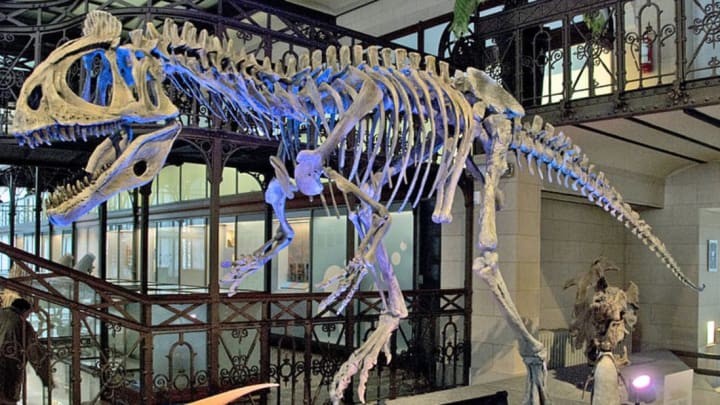10 Chilly Facts About Cryolophosaurus
By Mark Mancini

Dinosaurs once inhabited every continent and today, we’ll be strapping on our snowshoes to take a closer look at Antarctica’s dashiest species: Cryolophosaurus ellioti.
1. Cryolophosaurus Rocked some Offbeat Headgear.
This thing really cut an unusual profile. Generally, in theropod (aka “meat-eating”) dinosaurs, head crests run parallel to the sides of the skull. Yet rebellious Cryolophosaurus defies this trend. Like a fanning peacock tail, its curved crest faces forward.
2. Cryolophosaurus has Earned the Nickname “Elvisaurus” for its Presley-Esque Crest.
And, like a hunka hunka burning love, Cryolophosaurus probably used that dazzling ornament to attract the opposite sex.
3. One Unfortunate Cryolophosaurus May Have Choked to Death on a Rib.
Wedged inside the throat of one large Cryolophosaurus skeleton is what appears to be an herbivorous dinosaur’s rib. Did the big carnivore fatally gag on that bone? Perhaps. On the other hand, a few scientists have argued that this rib belonged to the Cryolophosaurus itself and was maneuvered into such an awkward position post mortem.
4. Dinosaur Fossils Didn’t Show Up in Antarctica Until the 1980s.
The South Pole finally yielded some dinosaur bones when the remains of an armored grazer were discovered on James Ross Island in 1986. However, this poor creature wouldn’t be given its official scientific name—Antarctopelta oliveroi—until 2006. Cryolophosaurus, meanwhile, was unearthed in 1991 and named in 1994.
5. A Few Other Antarctic Dinos Have Since Come to Light.
Add little Trinisaura, long-necked Glacialisaurus and an unnamed giant herbivore to this small-but-growing list.
6. Cryolophosaurus was Conspicuously Large for Its Time
One hundred and ninety million years ago, Cryolophosaurus ranked among the world’s biggest predatory dinosaurs, with an estimated length of over 20 feet. Truly huge varieties—like North America’s Allosaurus —wouldn’t start evolving until several million years later.
7. When Cryolophosaurus Lived, Antarctica Looked Quite Different.
Antarctica used to be significantly closer to the equator and even boasted its own forests. Also, the continent’s weather patterns were milder than those it currently withstands.
8. Scavengers Apparently Nibbled on One Specimen.
Some Cryolophosaurus bones have been found with nibble-like markings, possibly indicating that their owner became something’s dinner after kicking the bucket.
9. Cryolophosaurus Can Likely Tell Us a Great Deal About Dinosaurian Evolution.
As a primitive theropod from a region of the globe in which—until fairly recently—dinosaur fossils had never turned up, Cryolophosaurus seems rather promising to several paleontologists. At present, we’ve only got some incomplete cranial and skeletal material to go by. But if and when additional remains start emerging, who knows what surprises this creature might have in store for us?
10. A Recurring Character on PBS’ Dinosaur Train is Known as “King Cryolophosaurus.”
Does this guy’s singing voice remind you of a certain rock star we mentioned earlier? If so, the resemblance is probably 100 percent coincidental…